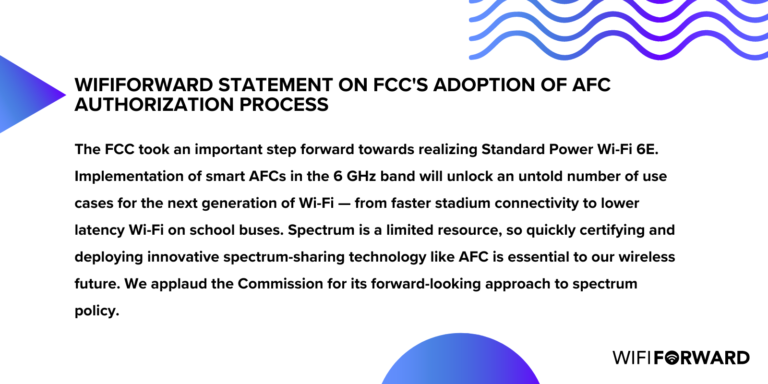At its September Open Meeting last week, the FCC began the process to authorize automated frequency coordination (AFC) systems in the 6 GHz band.
What do AFC systems do, you ask? Unlike the better-known National Football League conference, AFCs dynamically communicate the frequencies and maximum power levels that standard-power unlicensed devices can use in a given location to avoid interfering with incumbent licensed users of the band.

AFC Championship: No, not THAT one—sorry, NFL fans.
Image: Melissa McGovern on Unsplash
In adopting the 6 GHz Report and Order, the FCC made wide sections of the 6 GHz band (5.925–7.125 GHz) available for unlicensed devices. But in order to share this precious resource of spectrum, AFCs play referee for all the devices sharing the band.
Confused? Let’s make some real-life comparisons to illustrate what AFCs do. We ranked a variety of stand-ins for their shared qualities with AFC systems below.
Parents driving with two or more kids in the back seat: 4/10. AFC systems keep standard-power devices apart on the 6 GHz band somewhat like this father did with his three children, preventing devices from constant bickering and stealing each others’ snacks, or interference to incumbent devices already operating in the band.

Freight and passenger rail coordination: 8/10. Approximately 70% of Amtrak train routes are on tracks owned by freight railroads across the U.S. A coordinated schedule and careful diligence are necessary to prevent crashes on the system. Similarly, AFCs operating in the 6 GHz band are required to update their databases daily based on the FCC’s Universal Licensing System (ULS), which contains information on incumbent licensed microwave links, including their transmitter and receiver locations, frequencies, bandwidths, antenna height and other data. The AFC then is able to calculate which frequencies are available for standard APs to use.
Air traffic control: 9.5/10. Not only is ATC regulated by another federal agency (the FAA), it shares two of the same letters out of three in its acronym, requires advanced technology, maintains order in the air and performs heroic feats of coordination as demonstrated by the below gif.

Image: gyfycat
The Suez Canal Authority: 5/10. Optimizing the sharing of space in a narrow channel is indispensable here. AFCs calculate the necessary power levels and frequencies for a standard AP (access point) in a certain location, ensuring the standard AP Wi-Fi device is not blocking others’ operations. This is very important: without coordination, a blockage of the canal would result in a global shipping crisis. As funny as the resulting memes might be, none of us want chaos in the 6 GHz band. (A bonus Halloween pro tip: dressing as the Ever Given this year = a decent costume idea. You heard it here first. 🎃)
theyre actually doing it! ever given has been there so long that theyre actually going around the cape of good hope like 1700s scurvy patients oh my god pic.twitter.com/WjElTVfg1q
— soft punk gf (@AriaCallaghan) March 25, 2021
Sharing a bathroom with your roommates: 2/10. Unlike AFC systems, sharing one bathroom in your three-bedroom rowhouse is unpredictable, frustrating, not very well-coordinated and overall a pretty insufferable experience. We’ve given it two points because there’s typically no way two unrelated roommates living in a group house will occupy the same single bathroom at the same time, and the situation…works because there’s no other choice. Until you get in a fight about who has to clean the toilet this week.
Historic advancements for the #FutureOfWiFi. @FCC Commissioner @GeoffreyStarks statemennt on #6GHz automated frequency control systems, looking forward to “continuing our progress in making #unlicensed #spectrum available on a noninterference basis” #spectrumsharing #wifi pic.twitter.com/GzILJZWPkh
— WifiForward (@WifiForward) October 1, 2021
If all these gatekeepers can maintain order of limited resource sharing, then AFCs and spectrum surely are primed for success as well. We obviously think automated frequency coordinators in the 6GHz band rank 10/10, but will gladly engage in discussion of our rankings on Twitter, @WifiForward — see you there for the conversation!
